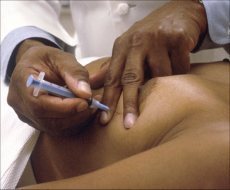by
Brendon Nafziger, DOTmed News Associate Editor | June 29, 2010

Less invasive techniques
by radiologists such as needle
biopsy are on the rise
Radiologists are performing a greater share of biopsies as image-guided and other less invasive techniques replace more aggressive procedures, according to a new study.
Radiologists went from performing close to a third of all biopsies nearly 10 years ago to now doing more than half, researchers said in an article appearing online Tuesday and in September in the print edition of Radiology.
The study also might help allay fears that the spread of advanced imaging modalities over the past decade has led to an increase in biopsies, as the researchers said the actual year-over-year growth rate for the potentially costly procedures was not large.



Ad Statistics
Times Displayed: 136626
Times Visited: 7924 MIT labs, experts in Multi-Vendor component level repair of: MRI Coils, RF amplifiers, Gradient Amplifiers Contrast Media Injectors. System repairs, sub-assembly repairs, component level repairs, refurbish/calibrate. info@mitlabsusa.com/+1 (305) 470-8013
"There have been some people concerned with all these imaging studies we're doing, that it leads to all these unnecessary procedures," Dr. Sharon Kwan, lead author of the paper and a clinical fellow at the University of California San in Francisco, told DOTmed News. "It's really not a tremendously high growth rate."
In the study, the researchers examined Medicare claims from 1997 to 2008, covering 10 anatomic regions, including the abdomen, breast, kidney, liver and musculoskeletal soft tissue.
They found that radiologists' share of biopsies jumped from around 35 percent of all biopsies in 1997 to nearly 56 percent in 2008, with a compound annual growth rate of 8 percent. By contrast, during the same period, general surgeons saw a drop in their shares from around 21 to 15 percent, the researchers said.
The study suggests part of the jump in radiologists' involvement is the increasing reliance on less invasive percutaneous needle biopsies. Unlike open biopsies, this procedure uses a slender needle inserted through the skin to obtain tissue samples.
Although the first such biopsy, on the liver, was recorded in the medical literature as far back as 1923, in the past doctors lacked available technology to make the technique practical. While some used fluoroscopy, others palpated tissue, if they could find it, or just did it blind.
"[They] used landmarks, for example, by knowing where the liver is relative to the ribs, and directing their needle," Kwan said. "We don't do that anymore."
Thanks to the proliferation of MRI, CT and other high-tech scans over the last decade, the researchers suggest, percutaneous needle biopsies, or PNBs, are now a solid majority of all biopsies performed, having shot up from 59 percent of all biopsies in 1997 to around 67 percent in 2008, with a CAGR of 5 percent. Non-PNB biopsies fell a CAGR of around 3 percent in the same period.

